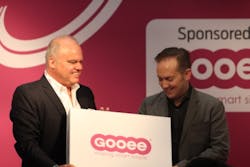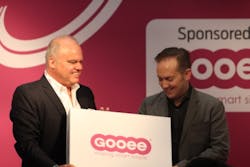Aurora has long been one of the industry's leading IoT champions, and could soon finally announce deployments. Its IoT boss discusses the business and technology challenges.
As lighting vendors try to morph from illumination providers into Internet of Things (IoT) linchpins, they face an ongoing series of technology tradeoffs as well as nothing less than rewriting their business model in a manner that could sometimes even exclude lighting itself as an offering.
Interested in articles & announcements on smart lighting & IoT?
So said the head of IoT for one of LED lighting's leading IoT champions, Aurora Group, as Aurora gets ready to reveal early pilot installations for its long-time-coming IoT products and services, a new business area that is expected to disrupt the conventional industry.
UK-based Aurora has been talking up the IoT for several years, and at one point had hoped to have installed Internet-connected commercial office lighting by 2016, if not earlier.
But as Aurora managing director of IoT Neil Salt told LEDs Magazinerecently, “Disruption can take a while.”
Salt made that observation a few weeks after Aurora provided a glimpse of AXiO, a line of luminaires that embed intelligence from Gooee, the IoT startup founded and headed by Andrew Johnson, who also founded and runs Aurora. Gooee has reached agreements to provide its chipsets to more than 30 lighting companies including Aurora, Feilo Sylvania, and John Cullen, to name a few.
Last November, Aurora's MD of IoT Neil Salt (r) took ceremonial delivery of smart lighting chipsets from Gooee chief commercial officer Jan Kemeling, at the LuxLive exhibition. Aurora might soon disclose its first pilot users of the technology. (Photo credit: Mark Halper.)
With 2017's third quarter rapidly approaching, Aurora is expected to soon pull back the curtains on at least one — if not several — early trial users of AXiO, paving the way to full-blown commercial implementations by 2018.
There are myriad reasons why getting there has been such a slog. Among them: Assuming that end users even want IoT lighting, the big question is what do they want to do with it?
“Some customers want wireless control, while others want to engage with their employees, or they want to optimize their space,” said Salt. “So we need to make sure that we start rolling this out in a meaningful way, and validate a lot of the value propositions.”
Translation: IoT lighting can serve a multitude of purposes, not all of which every user will want. Some might prefer it as a means to assert more control over their lighting by pushing buttons on a smartphone or pre-programming an application so that lights dim, brighten, or turn color temperatures in response to cues sent wirelessly. Others might want to gather room occupancy data to control other building management systems such as heating and air conditioning. Or the data could tell whether rooms and offices are under- or over- utilized, thus helping them to re-allocate physical space. Smart lighting can engage customers in a store by sending them personalized messages and promotions and guiding them to discounts; likewise, it can help track goods moving in and out of warehouses or retail shelves. And so on.
Exactly how a user wants to deploy smart lighting can therefore affect a lighting vendor's decision on which chips and sensors to embed in a luminaire.
Aurora is taking what Salt calls a “smart ready” approach that allows for most or all of these scenarios, but Aurora would activate only the functions the customer requests. The company has worked out its approach based on Gooee's long and considered development and fine tuning of a system that combines Bluetooth beacons with “heat mapping” sensors and with sensors that record the performance of light sources.
One of Aurora's first smart installations is expected to dynamically alter the lighting in different areas of a retail space in a manner that attracts customers to certain products or displays on the floor.
And then there's the question of which technologies to use. This, as much as anything, is holding up mass adoption of smart IoT lighting, as a panoply of different technologies can accomplish similar objectives but often don't communicate well with each other. Wireless schemes including Wi-Fi, Bluetooth, ZigBee, Z-Wave, NarrowBand IoT, VLC, Thread, and recently, IoT Ready, all enter the conversation as do wired approaches such as Power over Ethernet.
For its part, Aurora — and Gooee, for that matter — is leaning heavily on Bluetooth beacons. Gooee embeds Bluetooth transmitters in the chipsets that Aurora uses. Both companies have been frustrated by the absence so far of a standard for a mesh topology for Bluetooth. Simply put, a mesh approach improves the effectiveness of using Bluetooth-equipped lights to provide location services or engage with customers or employees, because it extends Bluetooth's range beyond 30 ft. A Bluetooth mesh standard was expected from the Bluetooth Special Interest Group in 2016. Optimists are hopeful that one is now only weeks away.
“When that happens, it will be a game changer,” said Salt.
Putting aside all the technology choices and obstacles, lighting companies face another big challenge in the shift to IoT strategies.
“I think it's going to change the business model of how we go to market as an industry,” said Salt. (He's not the only one to articulate a radical business shift. Osram head of connected lighting Stijn Bröcker recently called for a complete overhaul in lighting business models).
Salt noted that lighting vendors might even find themselves offering sensors and other IT devices that don't necessarily reside in luminaires. Such a move might make lighting companies look more like an IT outfit. Indeed, Osram itself has done just that, providing Bluetooth chips, but not lights, to a Swiss retail group for use in indoor positioning systems at 23 stores.
“Lighting companies may not sell lights in the future in some installations,” Salt noted. “They have the channel. They have the customers, and it may be that they did a lighting installation two or three years ago, and they come back and say 'Hey, now we offer this.' Aurora could go and just install sensors, and it can attach them to our lights or to other people's. It's very rare that any one lighting company is going to have every product in every installation without engaging with other partners. I think it's going to change the business model of how we go to market as an industry. We could just supply sensing. Or sensing and controls or sensing and controls and luminaires. Who knows?”
The Holy Grail of any IoT business strategy will be to monetize the data collected by the IoT system.
“The key is, can you put it all in one place, can you interrogate it in an efficient way, and then can you create value out of that by some kind of action?” Salt mused. “If you can close that loop up and then figure out how to sell it, that's the key.”
He noted, for instance, that data from inside retail stores could help map interior spaces in the same expansive way that GPS has led to the ubiquity of Google Maps for outdoor areas. Using London department store Selfridge's as an example, he noted, “If Selfridge's was covered with lights with beacons in it, and if Google had access to that information, now your indoor positioning would transfer seamlessly from Google Maps to inside the building.”
Of course, the lighting industry will face competition from the IT industry, which will emphasize that technologies such as indoor positioning do not have to be embedded in lighting systems. Lighting vendors will counter that lights are everywhere and thus form the backbone of a more efficient and more thoroughly mapped system.
It's battle that in Aurora's case won't be officially underway until it finally lands a few IoT customers. Its long wait could soon be over.
MARK HALPERis a contributing editor for LEDs Magazine, and an energy, technology, and business journalist ([email protected]).






